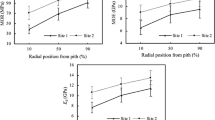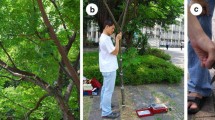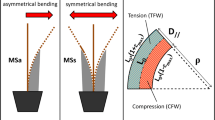Abstract
Key message
Sycamore and ash trees were found to be greater E in their coppices, but horse chestnut was stiffer in its branches, this could be related to node frequency.
Abstract
In this study, mechanical and anatomical properties of branch and coppice shoots of sycamore, horse chestnut and common ash were investigated along the length of their shoots and to relate these differences to their morphology and wood density. A series of 3-point bending tests were made along the lengths of the branches and coppices shoots at different diameters to determine the mechanical properties. The morphology was also characterized. Our results showed clearly that sycamore and horse chestnut trees were found to have greater flexural stiffness (EI) in their branches than the coppices, but coppices were stiffer (higher E) than branches in ash. Sycamore also surprisingly showed greater flexibility (higher E) in its coppices than the branches. The differences between branch and coppice shoots were explained by the morphology. Since the clearest morphological differences between the branches and coppices were in leaf node frequency, and linear regression analysis showed that the mechanical properties were negatively affected by higher leaf node frequency. Sycamore and ash had more leaf nodes in their branches than coppice shoots and consequently the mean E was lower in the branches; conversely horse chestnut had more leaf nodes in its coppice shoots which consequently had a lower mean E. The leaf nodes could also provide greater flexibility in the parallel plane since there is gap in nodal region and the arrangement of fibres are quite different here. The morphological differences could explain lower mechanical properties around the nodal region. The results also showed that mechanical properties were higher at the base and lower at the tips of branch and coppice shoots. These results cast light on the use of coppicing in particular tree species.















Similar content being viewed by others
References
Almeras T, Fournier M (2009) Biomechanical design and long-term stability of trees: morphological and wood traits involved in the balance between weight increase and the gravitropic reaction. J Theor Biol 256:370–381
Anten NP, Schieving F (2010) The role of wood mass density and mechanical constraints in the economy of tree architecture. Am Nat 175:250–260
Bealer A (1996) Old ways of working wood. Castle Books, Edison
Beismann H, Wilhelmi H, Bailleres H, Spatz HC, Bogenrieder A, Speck T (2000) Brittleness of twig bases in the genus Salix: fracture mechanics and ecological relevance. J Exp Bot 51:617–633
Bergman BA, Ewers FW, Bobich E (2009) Effect of leaf nodes on the mechanical properties of stems. Botany and Mycology 2009 (abstract). http://2009.botanyconference.org/engine/search/index.php?func=detail&aid=134
Bertram JEA (1989) Size-dependent differential scaling in branches: the mechanical design of trees revisited. Trees 4:241–253
Blake TJ (1980) Effects of coppicing on growth rates, stomatal characteristics and water relations in Eucalyptus camaldulensis Dehn. Aust J Plant Physiol 7:81–87
Blake TJ (1983) Coppice systems for short rotation intensive forestry: the influence of cultural, seasonal and plant factors. Aust For Res 13:279–291
Briand CH, Campion SM, Dzambo DA, Wilson KA (1999) Biomechanical properties of the trunk of the devil’s walking stick (Aralia spinosa, Araliaceae) during the crown-building phase: implications for tree architecture. Am J Bot 86:1677–1682
Bruechert F, Becker G, Speck T (2000) The mechanics of Norway Spruce [Picea abies (L.) Karst]: the mechanical properties of standing trees from different thinning regimes. For Ecol Manag 135:45–62
Cannell MGR, Morgan J (1987) Young’s modulus of sections of living branches and tree trunks. Tree Physiol 3:355–364
Caringella MA, Bergman BA, Stanfield RC, Ewers MM, Bobich EG, Ewers FW (2014) Effects of phyllotaxy on biomechanical properties of stems of Cercis occidentalis (Fabaceae). Am J Bot 101:206–210
Dahiya P, Milioni D, Wells B, Stacey N, Roberts K, McCann MC (2005) A RING domain gene is expressed in different cell types of leaf trace, stem, and juvenile bundles in the stem vascular system of zinnia. Plant Physiol 138(3):1383–1395
Dahle GA, Grabosky JC (2010) Allometric patterns in Acer platanoides (Aceraceae) branches. Trees Struct Funct 24:321–326
Dickmann DI, Nguyen PV, Pregitzer KS (1996) Effects of irrigation and coppicing on aboveground growth, physiology and fine-root dynamics of two field-grown hybrid poplar clones. For Ecol Manag 80:163–174
Ennos AR (1997) Wind as an ecological factor. Trends Ecol Evol 12:108–111
Ennos AR (2001) Trees. The Natural History Museum, London
Eugster W (2008) Wind effects. In: Jorgensen SE, Fath BD (eds) Ecological processes, vol 5 of encyclopedia of ecology. Elsevier, Oxford, pp 3794–3803
Fegel AC (1941) Comparative anatomy and varying physical properties of trunk, branch, and root wood in certain northeastern trees. Bull NY State Coll Syracuse Univ 14 No. 2b Tech Publ No 55:1–20
Fournier M, Dlouha J, Jaouen G, Almeras T (2013) Integrative biomechanics for tree ecology: beyond wood density and strength. J Exp Bot 64:4793–4815
Fuller RJ, Warren MS (1990) Coppiced woodlands. Nature Conservancy Council/HMSO, London
Grace J, Russell GR (1977) Effect of wind on grasses. J Exp Bot 28:268–278
Gunning BES, Pate JS, Green LW (1970) Transfer cells in vascular system of stems: taxonomy, association with nodes, and structure. Protoplasma 71:147–171
Gurau L, Mansfield-Williams H, Irle M (2003) An analysis of wood surface roughness data. In: Beall FC (ed) Proceedings of the 13th international symposium on nondestructive testing of wood. Forest Products Society, Madison, USA, pp 17–25
Haberlandt G (1928) Physiological plant anatomy. MacMillian and Co., London
Hacke UG, Sperry JS, Ewers BE, Ellsworth DS, Schafer KVR, Oren R (2000) Influence of soil porosity on water use in Pinus taeda. Oecologia 124:495–505
Hakkila P (1969) Weight and composition of the branches of large Scots pine and Norway spruce trees. Commun Inst For Fenn 67:1–37
Jackson RB, Banner JLE, Jobbagy G, Pockman WT, Wall DH (2002) Ecosystem carbon loss with woody plant invasion of grasslands. Nature 418:623–626
James KR, Haritos N (2014) Branches and damping on trees in winds. In: Smith ST (ed) 23rd Australasian conference on the mechanics of structures and materials (ACMSM23), vol II, Byron Bay, NSW, 9–12 December, Southern Cross University, Lismore, NSW, pp 1011–1016. ISBN: 9780994152008
James KR, Haritos N, Ades PK (2006) Mechanical stability of trees under dynamic loads. Am J Bot 93:1522–1530
James KR, Dahle GA, Grabosky J, Kane B, Detter A (2014) Tree biomechanics literature review: dynamics. J Arboric Urban For 40:1–15
Kauppi A, Kiviniitty M, Ferm A (1988) Growth habits and crown architecture of Betula pubescens Ehrh. of seed and sprout origin. Can J For Res 18:1603–1613
Kauppi A, Kiviniitty M, Ferm A (1990) Leaf morphology and photosynthetic rate in birch seedlings and stump sprouts. Can J For Res 20:952–960
Lichtenegger H, Reiterer A, Stanzl-Tschegg SE, Fratzl P (1999) Variation of cellulose microfibril angles in softwoods and hardwoods—a possible strategy of mechanical optimization. J Struct Biol 128:257–269
Lindstrom H, Evans JW, Verril SP (1998) Influence of cambial age and growth condition on microfibril angle in young Norway spruce [Picea abies [L.] Karst.]. Holzforschung 52:573–581
LoGullo MA, Salleo SE, Piaceri C, Russo R (1995) Relations between vulnerability to xylem embolism and xylem conduit dimensions in young trees of Quercus cerris. Plant Cell Environ 18:661–669
Lundström T (2010) Mechanical stability and growth performance of trees. PhD thesis no. 1644, University of Fribourg, Switzerland
McMahon T (1973) Size and shape in biology. Science 179:1201–1204
Mosbrugger V (1990) The tree habit in land plants. Springer, Berlin
Niklas KJ (1992) Plant biomechanics: an engineering approach to plant form and function. The University of Chicago Press, Chicago, pp 48–122
Niklas KJ (1994) The allometry of safety-factors for plant height. Am J Bot 81:345–351
Niklas KJ (1996) Differences between Acer saccharum leaves from open and wind-protected sites. Ann Bot 78:61–66
Niklas KJ (1997a) Mechanical properties of black locust (Robinia pseudoacacia L.) wood: size- and age-dependent variations in sap and heartwood. Ann Bot 79:265–272
Niklas KJ (1997b) Size- and age-dependent variations in the properties of sap- and heartwood in black locust (Robinia pseudoacacia L.). Ann Bot 79:473–478
Niklas KJ (1997c) Mechanical properties of black locust (Robinia pseudoacacia L.) wood: correlations among elastic and rupture moduli, proportional limit, and tissue density and specific gravity. Ann Bot 79:479–485
Niklas KJ (1997d) Responses of hollow septate stems to vibrations: biomechanical evidence that nodes can act mechanically as spring-like joints. Ann Bot 80:437–448
Niklas KJ, Spatz HC (2012b) Mechanical properties of wood disproportionately increase with increasing density. Am J Bot 99:169–170
Richter JP (1970) The notebooks of Leonardo da Vinci: compiled and edited from the original manuscripts. Dover Publications, New York
Rinne P, Saarelainen A, Junttila O (1994a) Growth cessation and bud dormancy in relation to ABA level in seedlings and coppice shoots of Betula pubescens as affected by a short photoperiod, water stress and chilling. Physiol Plant 90:451–458
Rinne P, Tuominen H, Junttila O (1994b) Seasonal changes in bud dormancy in relation to bud morphology, water and strach content, and abscisic acid concentration in adult trees of Betula pubescens. Tree Physiol 14:549–561
Rowe NP, Speck T (1999) Biomechanical variation of non-selfsupporting plant growth habits: a comparison of herbaceous and large-bodied woody plants. In: Edelin C (ed) L’Arbre, Biologie et Developpement. Naturalia Montspeliensia numero hors serie A7, pp 1 ± 11
Salleo S, LoGullo MA (1986) Xylem cavitation in nodes and internodes of whole Chorisia insignis H. B. et K. plants subjected to water stress: relations between xylem conduit size and cavitation. Ann Bot 58:431–441
Schulgasser K, Witztum A (1992) On the strength, stiffness and stability of tubular plant stems and leaves. J Theor Biol 155:497–515
Smith VC, Ennos AR (2003) The effects of air flow and stem flexure on the mechanical and hydraulic properties of the stems of sunflowers Helianthus annuus L. J Exp Bot 54:845–849
Sone K, Noguchi K, Terashima I (2006) Mechanical and ecophysiological significance of the form of a young Acer rufinerve tree: vertical gradient in branch mechanical properties. Tree Physiol 26:1549–1558
Spatz HC, Bruechert F (2000) Basic biomechanics of self-supporting plants: wind loads and gravitational loads on a Norway spruce tree. For Ecol Manag 135:33–44
Spatz HC, Speck T (1994) Local buckling and other modes of failure in hollow plant stems. Biomimetics 2:149–173
Spatz HC, Theckes B (2013) Oscillation damping in trees. Plant Sci 207:66–71
Spatz HC, Speck T, Vogellehner D (1990) Contributions to the biomechanics of plants. I. Stabilities of plant stems with strengthening elements of different cross sections against weight and wind forces. Bot Acta 103:111–122
Spatz HC, Boomgaarden CH, Speck T (1993) Contributions to the biomechanics of plants. III. Experimental and theoretical studies of local buckling. Bot Acta 106:254–264
Spatz HC, Beismann H, Emmans A, Speck T (1995) Mechanical anisotropy and inhomogeneity in the tissues comprising the hollow stem of the giant reed Arundo donax. Biomimetics 3:141–155
Spatz HC, Bruechert HF, Pfisterer J (2007) Multiple resonance damping or how do trees escape dangerously large oscillations? Am J Bot 94:1603–1611
Speck T, Rowe NP (1999) A quantitative approach for analytically defining growth form and habit in living and fossil plants. In: Kurmann MH, Hemsley AR (eds) The evolution of plant architecture. Royal Botanic Gardens, Kew, pp 447–479
Suzuki M, Hiura T (2000) Allometric differences between current-year shoots and large branches of deciduous broad-leaved tree species. Tree Physiol 20:203–209
Telewski FW (2012) Is windswept tree growth negative thigmotropism? Plant Sci 184:20–28
Thomas P (2000) Trees: their natural history. Cambridge University Press, Cambridge
Tyree MT, Zimmermann MH (2002) Xylem structure and the ascent of sap, 2nd edn. Springer, Berlin, p 283
Utsumi Y, Bobich EG, Ewers FW (2010) Photosynthetic, hydraulic and biomechanical responses of Juglans californica shoots to wildfire. Oecologia 164:331–338
Van Casteren A, Sellers WI, Thorpe SKS, Coward S, Crompton RH, Ennos AR (2012) Why don’t branches snap? The mechanics of bending failure in three temperate angiosperm trees. Trees 26:789–797
Vincent JFV (1992) Biomechanics materials a practical approach. Oxford University Press, Oxford
Vollsinger S, Mitchell SJ, Byrne KE, Novak MD, Rudnicki M (2005) Wind tunnel measurements of crown streamlining and drag relationships for several hardwood species. Can J For Res 35:1238–1249
Wilson BF (1968) Red maple stump sprouts: development the firstyear. Harvard Forest Paper No. 18
Woodrum CL, Ewers FW, Telewski FW (2003) Hydraulic, biomechanical, and anatomical interactions of xylem from five species of Acer (Aceraceae). Am J Bot 90:693–699
Yoshida M, Okuyama T, Yamamoto H (1992a) Tree forms and internal stresses. III. Growth stresses of branches. Mokuzai Gakkaishi 38:663–668
Yoshida M, Okuyama T, Yamamoto H, Sugiyama K (1992b) Tree forms and internal stresses. II. Stresses around the base of a branch. Mokuzai Gakkaishi 38:657–662
Zimmermann MH (1978a) Hydraulic architecture of some diffuse-porous trees. Can J Bot 56:2286–2295
Zimmermann MH (1978b) Structural requirements for optimal water conduction in tree stems. In: Tomlinson PB, Zirnmermann MH (eds) Tropical trees as living systems. Cambridge University Press, Cambridge
Zimmermann MH, Sperry JS (1983) Anatomy of the palm Rhapis excelsa. IX. Xylem structure of the leaf insertion. J Arnold Arbor 64:599–609
Acknowledgements
Prof. Dr. Ulrich E. Luettge provided useful editorial comments that we gratefully acknowledge. We also would like to thank our anonymous reviewers for the great effort they have put into reviewing our paper.
Author information
Authors and Affiliations
Corresponding author
Ethics declarations
Conflict of interest
The authors declare that they have no conflict of interest.
Additional information
Communicated by H. Gaertner.
Rights and permissions
About this article
Cite this article
Özden, S., Ennos, R. The mechanics and morphology of branch and coppice stems in three temperate tree species. Trees 32, 933–949 (2018). https://doi.org/10.1007/s00468-018-1687-y
Received:
Accepted:
Published:
Issue Date:
DOI: https://doi.org/10.1007/s00468-018-1687-y




